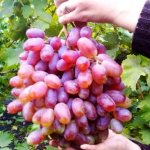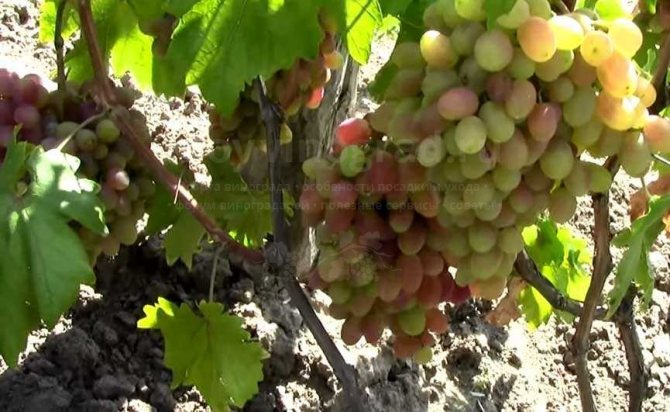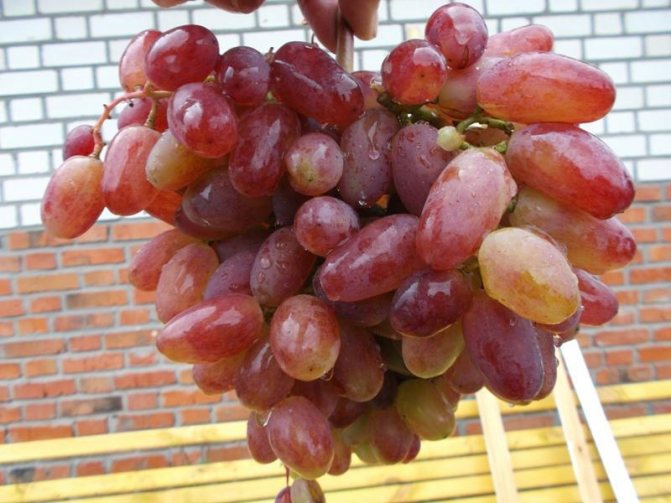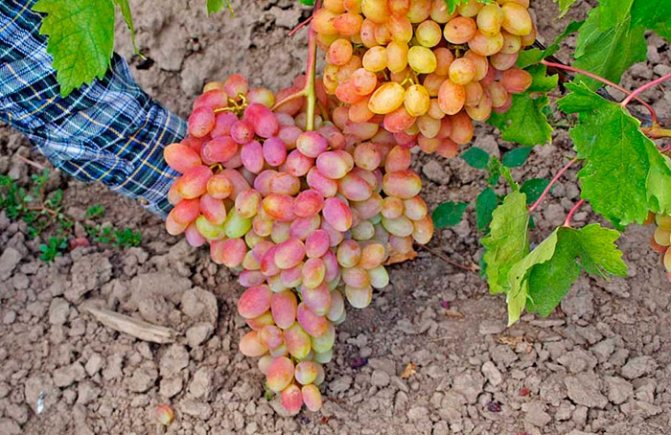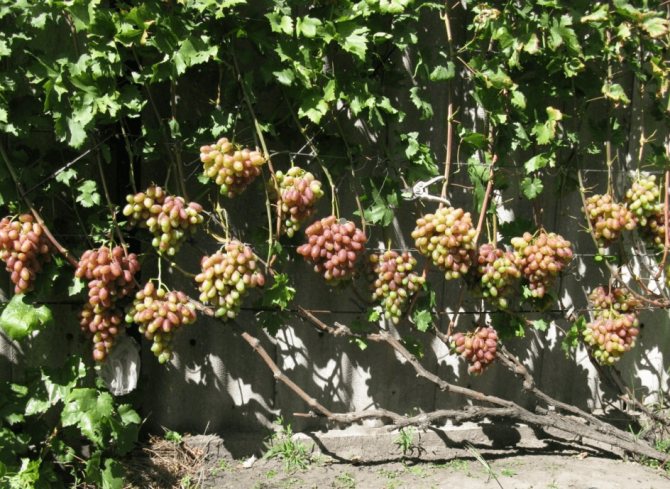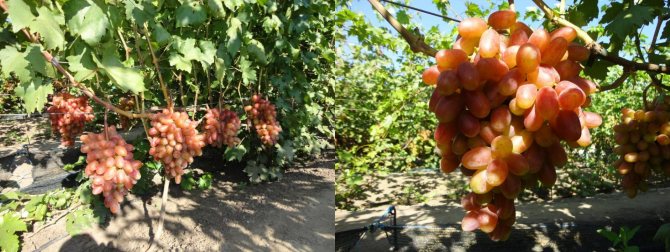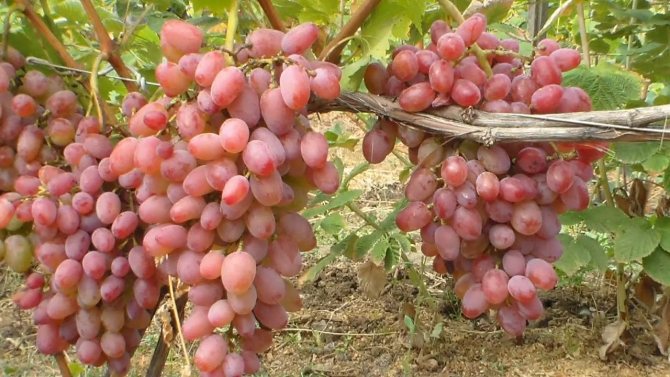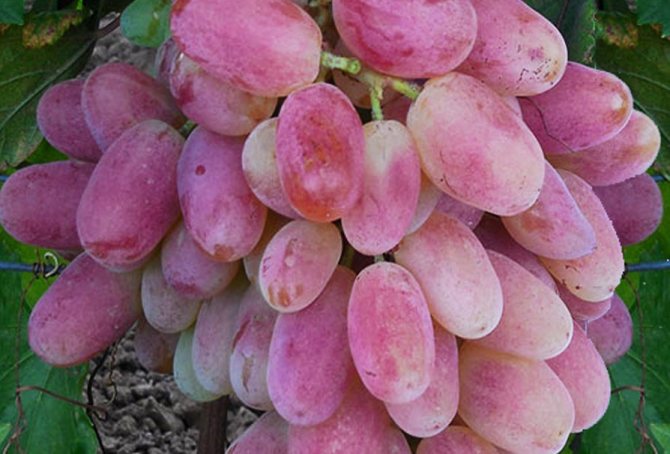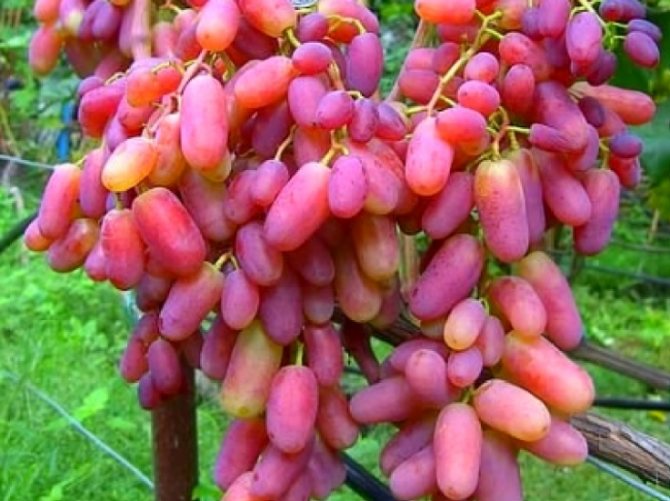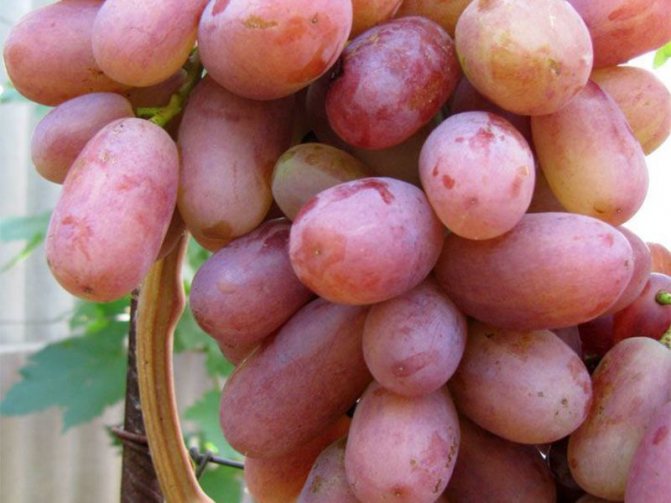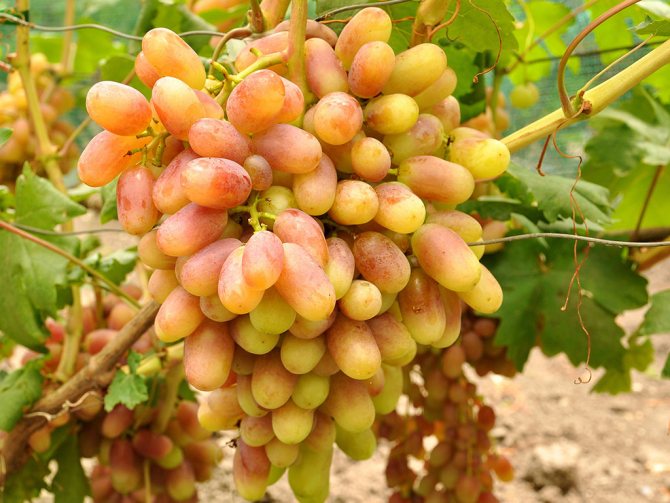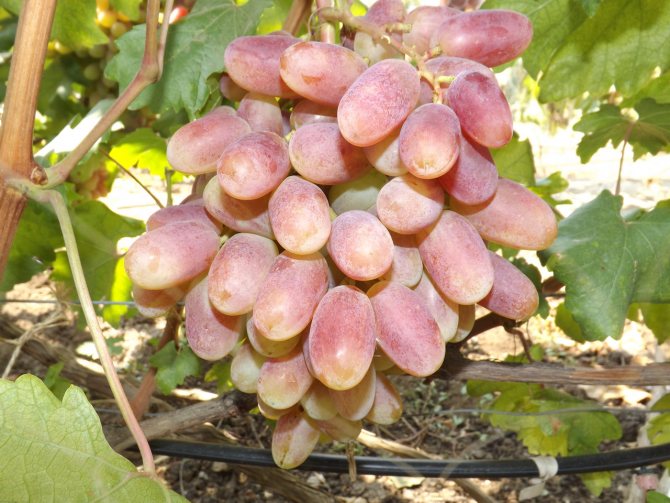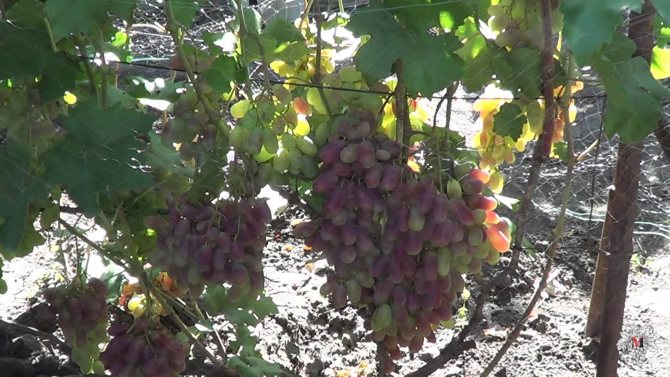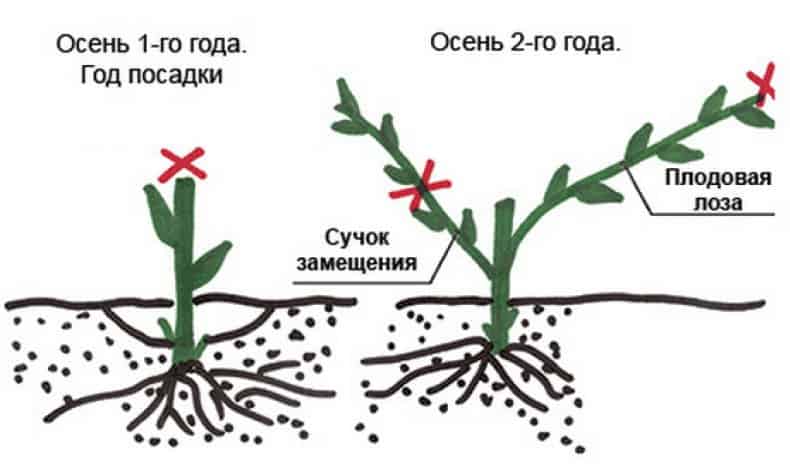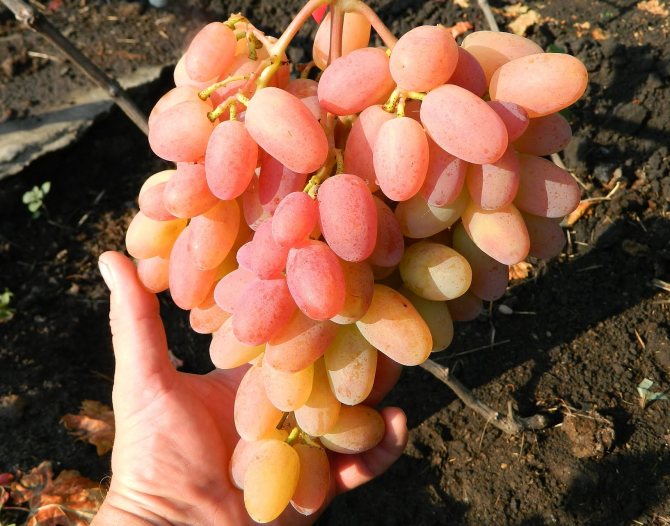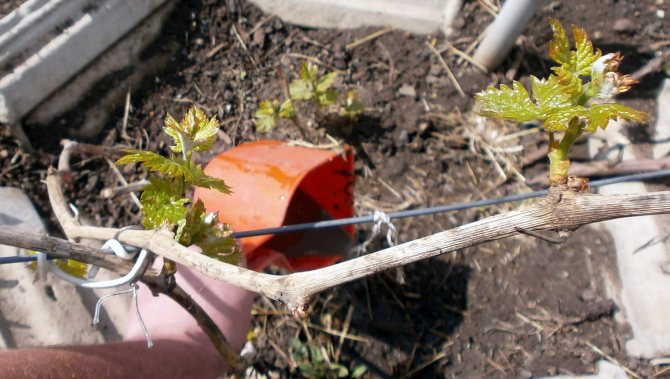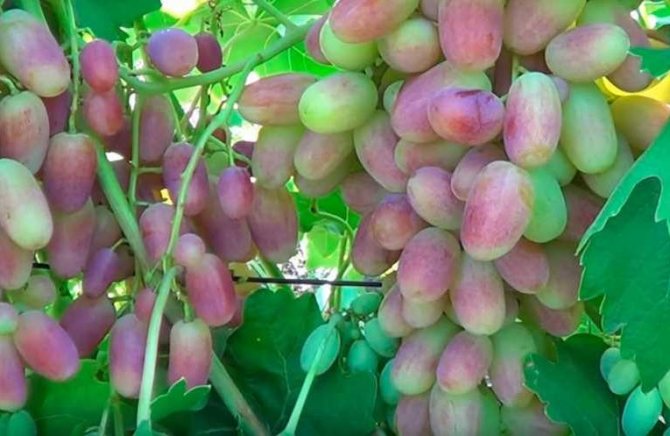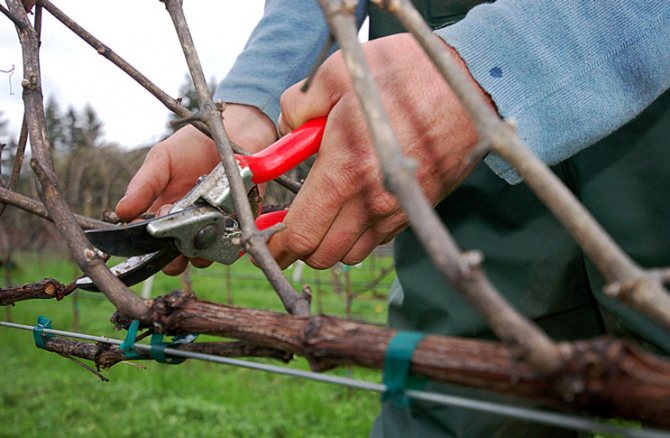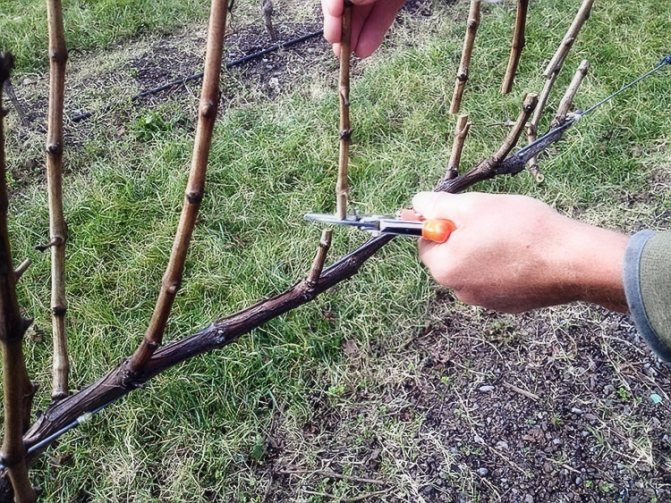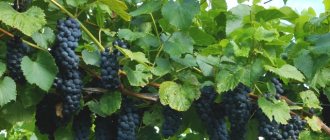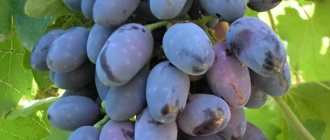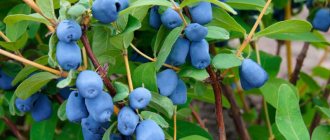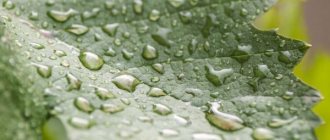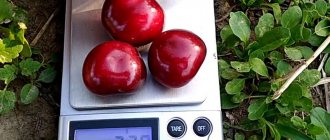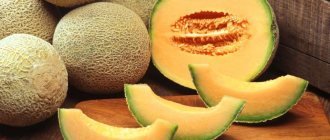What species does it belong to?
Julian is a super-early maturing table variety of pink grapes. It is used in winemaking for the blending of dessert wines, as well as in juices and juice-containing products.
White Miracle, Pink Grape and Tason also differ in their early ripening period.
These grapes can be stored and transported without fear for the safety of its presentation and taste characteristics. For this, he is in great demand.
Pros and cons
Like all varieties, Julian has its pros and cons, although there are more advantages than disadvantages.
See also
Description and characteristics of the grape variety Korinka Russkaya, advantages and disadvantages, cultivationRead
Minuses:
- Choosing a landing site. Of great importance in the ripening period is the choice of a sunny location, without drafts and closely located groundwater.
- Sharp weather changes from plus to minus can damage young vines, although this variety is considered frost-resistant.
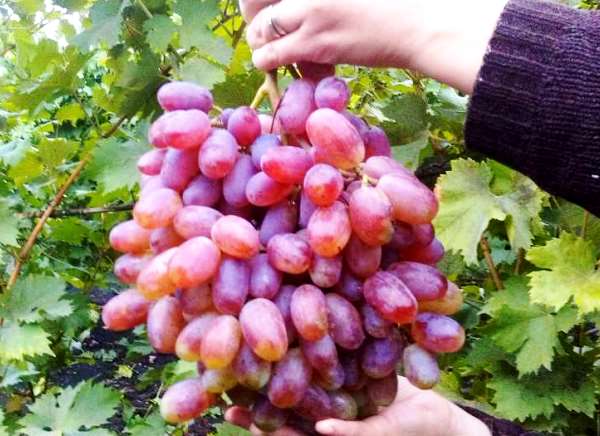
Pros:
- Long-term storage of brushes that do not deteriorate externally.
- Resistant to mildew and other fungal diseases.
- Delicious, large, sweet berries, without bitterness.
- It grows quickly and adapts to new conditions.
- Is not attacked by wasps.
- Fruiting of signal brushes begins from the 2nd year of the seedling's life.
- It tolerates hot, dry summers.
- The harvest is early and abundant.
Julian is one of the best varieties suitable for fresh and processed consumption: jam, juice, wine, raisins, compote, jam, marmalade.
Julian grapes: variety description
The growth vigor of the bush is above average. The bunch is very large (average weight 1 kg), elongated, shaped like a cylinder. In appearance it is similar to the “parental” Rizamat, medium friability, without peas. The berries are golden-pink to light lilac, large, elongated, pointed at the bottom, very dense and elastic.
The stalks are long, light green. The skin is dense, but thin, almost imperceptible when eaten. Flowers are hermaphrodite. The shoot is a deep brown color with reddish nodules. The vine is powerful, dark brown in color. The leaf is medium in size, rounded, cordate, medium cut.
Montepulciano, Hadji Murat and Tien Shan also have bisexual flowers.
Variety reviews
Julian and this year only pleases with a very good resistance to diseases, strength of growth, productivity, and has already begun to color! The bunches are large, the berry also continues to grow and increase in size. A week ago there was a very heavy downpour. The only berry that I continue to observe has burst. The cracks do not rot, they just dry out, there are no berries baked in the sun either. The seedling is the second year. Ripened simultaneously with Victor and the Transfiguration. Good sugar accumulation, crunchy taste, white-pink color. For another month I hung on a bush in a bag, it became sweeter.
Popov Evgeny Alexandrov
For me, Julian is the closest in terms of maturation to the Transfiguration. The taste differs slightly from the latter, quite decent. In terms of yield, both are close, you just need to be more careful with the load. And if you load, then be sure to feed and water the bushes. By and large, Julian is very close to the Troika: outwardly, neither the leaf nor the crown are practically different; also willingly lays decent clusters on stepsons.Now on it and throughout the Troika, the berries on the stepsons have begun to color and have reached the size of the berries of a good Augustine, by October a second harvest of a decent size will be ready. A vineyard friend, having seen and tried YULIAN, asked me to give him 5–6 cuttings of this GF in the fall. He said that this is the best grape, but his Troika grows and bears fruit. This means that the person has caught the difference.
Vladimir Karkoshkin
Wonderful berries of the Julian variety are not inferior in taste to table raisins. The unusual taste and shape of the fruit has long made the grape hybrid popular among many gardeners. It invariably remains the earliest and most delicious berry among the hybrids of recent years. If you do not neglect the peculiarities of cultivation, he will certainly become a long-liver on the site and will delight with delicious bunches already at the beginning of August.
Photo
Photo of Julian grapes:
Breeding history
The Julian variety was bred by an amateur breeder V.U. Kapelyushny. It appeared as a result of crossing the Kesha and Rizamat varieties. Despite the breeders' statement about resistance to cold weather, it still feels better in regions with a warm and temperate climate, where there is no severe cold.
These are Crimea, Ukraine, Moldova, the Caucasus. The middle band with its "minuses" can be fatal for Julian. In general, the characteristics of the variety are currently being tested.
Ataman Pavlyuk, the Descendant of Rizamat and Crimson also belong to his hand.
How to plant grapes correctly
Planting grapes is the fulfillment of the following points:
- In the fall, pits or trenches are prepared for planting. The stage includes the device of good drainage and filling the hole with nutrient soil.
- The roots of purchased seedlings are shortened. On the shoot itself, 4-5 eyes are left.
- Before planting, the roots are dipped in a mixture of creamy consistency, consisting of manure, fertile soil and one of the known growth stimulants.
Advice. It is better to plant grapes in the rows from north to south. If the site is on a slope, then it is transverse to it.
- A mound is formed at the bottom of the pit in order to evenly distribute the roots during planting.
- Set the seedling with the buds towards the north, and the roots towards the south. The root heel should be about 50 cm deep.
- The planting is watered with water, not strongly tamped. In the future, the seedlings are watered daily through a tube. This will allow the root system to form quickly.
After 3 years after planting, you can enjoy the first berries.
Characteristics
The variety has good frost resistance - up to minus 23 degrees Celsius. Relatively resistant to powdery mildew, gray rot, spider mites. Wasps are almost not scary to Julian. Differs in high sugar accumulation - up to 28%. The berry taste is sweet, nutmeg, with a rich aftertaste and a light strawberry flavor.
It goes well with other varieties and rootstocks. The yield is high, so the bushes need timely pruning of their eyes. The norm of eyes is no more than 45 per bush.
Among the frost-resistant varieties, one can also name Vanyusha, Zagrava and Rosy.
Growing tips
Like most other grape varieties, Julian's seedlings prefer a windless place open to the sun, preferably on the southern side of the site. Planting seedlings can be done both in spring and autumn, but spring is, of course, preferable.
The soil should be above + 10 ° C. In the northern regions, the only possible option is to plant in spring. The recommended distance between seedlings is 1 m.
Landing
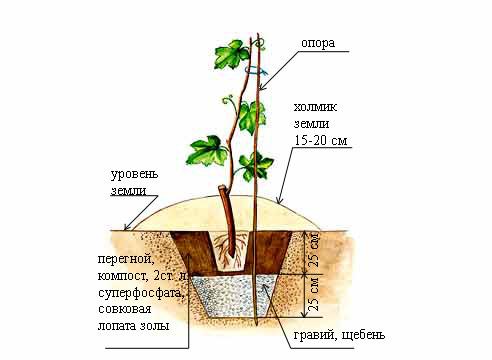

Planting rules are the same as for other grape varieties:
- In the prepared place, in the fall, pits or trenches up to 50 cm deep are made, at the bottom of which a fertile mixture is laid: soil, humus and fertilizer.
- In the spring, all damaged or dried shoots are removed from the selected seedlings, the roots are shortened to 15 cm and kept in a growth-stimulating solution for the allotted time.
- Before planting, a peg (wooden or steel) is driven into the hole, the seedling is carefully placed, tied up and covered with soil.
- The final stage is abundant watering, at least 1.5 buckets. After it, the soil will sag, so later the soil is poured over.
Important! Professionals advise to purchase planting material in regional nurseries or from other trusted sellers who can guarantee the quality of their goods. When buying, you should pay attention to the development of the root system - the better it is, the higher the survival rate of seedlings.
Growing
When growing grapes, Julian requires compliance with the following conditions:
- Watering. The variety needs abundant watering only during certain periods: a week before flowering, after the flowers have fallen, for 7 days. to shelter the bushes for the winter. During flowering and pouring of berries, watering is not done, and in case of heavy rains, they even make a shelter (canopy or visor) from excessive moisture;
- Pruning. Many novice growers make a mistake - they feel sorry for cutting off excess shoots, which can greatly affect the yield. The basic rule for pruning is 10 eyes per shoot, on the entire bush - a maximum of 50. It is best to prune before the start of sap flow. In the same way, foliage is thinned out to the required state;
- Top dressing. There is no need to be afraid of year-round fertilization, especially during the formation and growth of bunches. Top dressing should include both mineral and organic fertilizers. The first application of fertilizers should be in the spring during the first treatment of the site;
- Ripening acceleration. There are several such techniques. In June, ringing is carried out - the bark ring is removed on the shoot, which contributes to a faster harvest (about 10 days). Removing the pagon (chasing) and rolling into a ring also accelerate the ripening of the berries. The last method is twisting the vine, it is carried out when the berries are almost ripe.
Important! Although the variety is frost-resistant, it is recommended to cover the vine with special means for the winter.
Diseases and pests
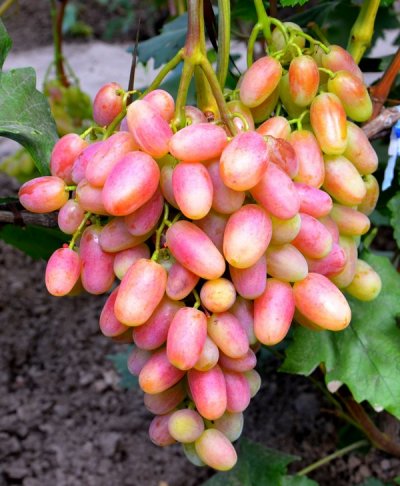

Farmers who decide to plant this variety on the site are in luck - he is almost not afraid of such enemies as wasps, gray rot, mildew and oidium, tick.
Almost - because at high temperatures (from +25 degrees) and humidity, the likelihood of fungal attacks increases. And, of course, one should beware of an attack "from the air" - birds are the first hunters to feast on ripe berries.
With birds, everything is simple - put a rigid barrier net, and let them fly until you get bored.
It is more difficult with bacteria, if only because not all farmers immediately recognize the onset of the disease. What misfortunes can attack the Julian grapes?
Alternaria. This is a very serious ailment, which, by its external manifestation, some farmers take for powdery mildew. It affects shoots, inflorescences, leaves, berries, making the latter unsuitable for food. To prevent it, you must follow the rules for storing berries. If the disease has already shown itself, it is fought by spraying the vineyards with a 2% solution of Bordeaux liquid.
Another disease, also dangerous, is anthracnose spotted. It appears as dark spots on the leaves, with dead areas inside.
This is a true ulcer in the vineyards of Ukraine, Crimea and Moldova, Krasnodar Territory and the Caucasus. And since Julian is quite thermophilic, he is also at risk. They also fight it with a solution of Bordeaux liquid - when the first shoots become at least 10 cm.
As for mildew or downy mildew, Julian is resistant to it, but at high temperatures, the likelihood of getting sick increases.They fight the disease by spraying with a solution of vitriol and organic fungicides. Among them are cinos, captan, dichlorfluanide, tiram and others.
Despite the fact that Julian is a strong, rather unpretentious variety, farmers still need to prevent fungal diseases and observe the storage conditions for fruits. At the first signs of defeat, measures should be taken immediately, then the fight against the disease will not require a lot of time and physical costs. It also doesn't hurt to take action against chlorosis, bacteriosis, rubella, and bacterial cancer.
Care
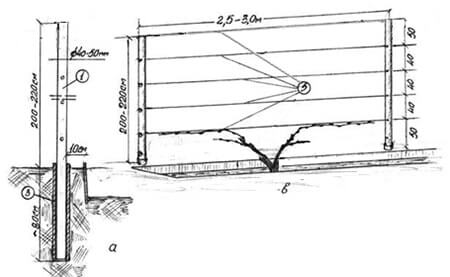

Landing
If you plan to buy Julian's seedlings for planting, you need to prepare a site where they will grow.
Do not forget that the Julian grape variety is vigorous, so the planting of seedlings should be carried out at least 2.5 m from each other.
The territory should be located in the southern part of the site, hidden from the through wind and open to sunlight.
If the soil is not fertile, it is worth feeding it thoroughly throughout the life of the plant. Use manure or compost to do this.
A fruitful variety like Julian requires a lot of nutrients and should be fed regularly and abundantly.
Potassium-phosphorus fertilizers are ideal for this grape, they should be dissolved in water and poured under the root. Also, you can use foliar dressing on a green leaf.
If the soil is too damp, drainage may be worthwhile. Grapes do not like swampy soils and places with dense shade.
If the soil in your area is very acidic, it may be areas located close to coniferous forests. To reduce the acidity level, add 200 g of lime per m2 and dig up.
We also recommend building a tensioned wire support system (you can use a single-plane or two-plane trellis).
To do this, dig into the ground the posts, up to 2.5 m high with a span of 2.5-3 m between them. Reinforce the posts along the edges with a support. Further, the lower row of wire is pulled at a distance of half a meter from the soil and at regular intervals of 45 cm. The subsequent rows. In the photo you can see the support scheme in more detail.
Bush formation and crop rationing
Pruning is a must-have item for grape care.
When forming Julian, we cut the vine into 8-10 buds, based on a load of 45 eyes per adult bush.
The strength of the growth of the Juliana bushes is great, with a powerful root system. Withstands well the load of the crop.
An important part of caring for a bush is the removal of unnecessary bunches - normalization. The procedure must be performed when the berries have become the size of a pea. It is at this stage that you can see how each brush develops. We recommend keeping 1-2 brushes, depending on the age and strength of the plant.
Watering
Julian is a variety that, unlike its progenitor "Rizamata", loves moisture, does not "tear the berry", reacts well to watering before and after flowering. During the period when the berries are ripe, it is not recommended to water the bushes, otherwise you can lose part of the harvest. In total, it is recommended to water 4-5 times per season, but it all depends on the weather conditions.
The final stage of irrigation procedures is carried out in the autumn season (water-charging irrigation), two to three weeks before the shelter of the vines, but if there was heavy rainfall, then there is no need to water the bushes.

